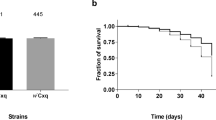Abstract
A total of 208 mosquitoes of the Culex pipiens complex from 15 basement and terrestrial populations collected in different regions of the European part of Russia and Siberia were examined by genetic methods. Among these, two major mitotypes, M and P, were identified. These mitotypes differed by six substitutions in the 246-bp mitochondrial DNA cytochrome oxidase I gene fragment examined. Urban basement mosquitoes C. pipiens (form molestus) were characterized by the presence of mitotype M and infection with the endosymbiotic bacteria of the genus Wolbachia. Mosquitoes of the C. pipiens complex inhabiting opened biotopes harbored mitotype P, or its variety, mitotype P1, and were not infected with Wolbachia. Thus, in natural conditions marked linkage disequilibrium between cytoplasmic elements, mitochondrial DNA and Wolbachia, can be observed. Similarity of mitotypes in form molestus mosquito from different geographical localities favors the hypothesis on the common ancestry of urban mosquitoes.
Similar content being viewed by others
REFERENCES
Hertig, M., The Rickettsia, Wolbachia pipientis (gen. et sp. n.) and Associated Inclusions of the Mosquito, Culex pipiens, Parasitology, 1936, vol. 28, pp. 453–486.
Yen, J.H. and Barr, A.R., New Hypothesis of Cause of Cytoplasmic Incompatibility in Culex pipiens L., Nature, 1971, vol. 232, pp. 657–658.
Werren, J.H., Windsor, D.W., and Guo, L.R., Distribution of Wolbachia among Neotropical Arthropods, Proc. R. Soc. London, B, 1995, vol. 262, pp. 197–204.
O’Neil, S.L., Giordano, R., Colbert, A.M.E., et al., 16S RNA Phylogenetic Analysis of the Bacterial Endosymbionts Associated with Cytoplasmic Incompatibility in Insects, Proc. Natl. Acad. Sci. USA, 1992, vol. 89, pp. 2699–2702.
Montchamp-Moreau, C., Ferveur, J.F., and Jacques, M., Geographic Distribution and Inheritance of Three Cytoplasmic Incompatibility Types in Drosophila simulans, Genetics, 1991, vol. 129, pp. 399–407.
Jiggins, F.M., Male-Killing Wolbachia and Mitochondrial DNA: Selective Sweeps, Hybrid Introgression and Parasite Population Dynamics, Genetics, 2003, vol. 164, pp. 5–12.
Behura, S.K., Sahu, S.C., Mohan, M., and Nair, S., Wolbachia in the Asian Rice Gall Midge, Orseolia oryzae (Wood-Mason): Correlation between Host Mitotypes and Infection Status, Insect Mol. Biol., 2001, vol. 10, pp. 163–171.
Marcad, I.I., Souty-Grosset, C., Bouchon, D., et al., Mitochondrial DNA Variability and Wolbachia Infection in Two Sibling Woodlice Species, Heredity, 1999, vol. 83, pp. 71–78.
Rigaud, T., Bouchon, D., Souty-Grosset, C., and Raimond, R., Mitochondrial DNA Polymorphism, Sex Ratio Distorters and Population Genetics in the Isopod Armadillidium vulgare, Genetics, 1999, vol. 152, pp. 1669–1677.
Vinogradova, E.B., Mosquitoes of the Culex pipiens Species Complex in Russia, Tr. ZIN RAN, 1997, vol. 271, p. 307.
Vinogradova, E.B., Fedorova, M.V., Shaikevich, E.V., and Zakharov, I.A., Endosymbiotic Bacteirum Wolbachia pipientis in Synanthropic Populations of Mosquitoes Culex pipiens pipiens L. (Diptera, Culicidae), Dokl. Akad. Nauk, 2003, vol. 389, no.6, pp. 837–841.
Juan, C., Omori, P., and Hewitt, G.M., Phylogeny of the Genus Hegeter (Tenebrionidae, Coleoptera) and Its Colonization of the Canary Islands Deduced from Cytochrome Oxidase I Mitochondrial DNA Sequences, Heredity, 1996, vol. 76, pp. 392–403.
Braig, H.R., Zhou, W., Dobson, S.L., and O’Neil, S.L., Cloning and Characterization of a Gene Encoding the Major Surface Protein of the Bacterial Endosymbiont Wolbachia, J. Bacteriol., 1998, vol. 180, pp. 2373–2378.
Nei, M. and Kumar, S., Molecular Evolution and Phylogenetics, New York: Oxford Univ. Press, 2000.
Solignac, M., Vautrin, D., and Rousset, F., Widespread Occurrence of the Proteobacteria Wolbachia and Partial Cytoplasmic Incompatibility in Drosophila melanogaster, C. R. Acad. Sci. Paris, Ser. III, 1994, vol. 317, pp. 461–470.
Schulenburg, J.H., Hurst, G.D., Tetzlaff, D., et al., History of Infection with Different Male-Killing Bacteria in the Two-Spot Ladybird Beetle Adalia bipunctata Revealed through Mitochondrial DNA Sequence Analysis, Genetics, 2002, vol. 160, pp. 1075–1086.
Fonseca, D.M., Keyghobadi, N., Malcolm, C.A., et al., Emerging Vectors in the Culex pipiens Complex, Sc-ence, 2004, vol. 303, pp. 1535–1538.
Platonov, A.E., West Nile Encephalitis in Russia, 1999–2001: Were We Ready? Are We Ready?, Ann. New York Acad. Sci., 2001, vol. 951, pp. 102–116.
Author information
Authors and Affiliations
Additional information
Translated from Genetika, Vol. 41, No. 3, 2005, pp. 320–325.
Original Russian Text Copyright © 2005 by Shaikevich, Vinogradova, Platonov, Karan, Zakharov.
Rights and permissions
About this article
Cite this article
Shaikevich, E.V., Vinogradova, E.B., Platonov, A.E. et al. Polymorphism of mitochondrial DNA and infection with symbiotic cytoplasmic bacterium Wolbachia pipientis in mosquitoes of the Culex pipiens (Diptera, Culicidae) complex from Russia. Russ J Genet 41, 244–248 (2005). https://doi.org/10.1007/s11177-005-0080-2
Received:
Issue Date:
DOI: https://doi.org/10.1007/s11177-005-0080-2




